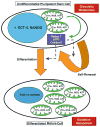Empowering self-renewal and differentiation: the role of mitochondria in stem cells
- PMID: 20809088
- PMCID: PMC3006229
- DOI: 10.1007/s00109-010-0678-2
Empowering self-renewal and differentiation: the role of mitochondria in stem cells
Abstract
Stem cells are characterized by their multi-lineage differentiation potential (pluripotency) and their ability for self-renewal, which permits them to proliferate while avoiding lineage commitment and senescence. Recent studies demonstrate that undifferentiated, pluripotent stem cells display lower levels of mitochondrial mass and oxidative phosphorylation, and instead preferentially use non-oxidative glycolysis as a major source of energy. Hypoxia is a potent suppressor of mitochondrial oxidation and appears to promote "stemness" in adult and embryonic stem cells. This has lead to an emerging paradigm, that mitochondrial oxidative metabolism is not just an indicator of the undifferentiated state of stem cells, but may also regulate the pluripotency and self-renewal of stem cells. The identification of specific mitochondrial pathways that regulate stem cell fate may therefore enable metabolic programming and reprogramming of stem cells.
Figures

Similar articles
-
Revisiting Mitochondrial Function and Metabolism in Pluripotent Stem Cells: Where Do We Stand in Neurological Diseases?Mol Neurobiol. 2017 Apr;54(3):1858-1873. doi: 10.1007/s12035-016-9714-8. Epub 2016 Feb 18. Mol Neurobiol. 2017. PMID: 26892627 Review.
-
Connecting Mitochondria, Metabolism, and Stem Cell Fate.Stem Cells Dev. 2015 Sep 1;24(17):1957-71. doi: 10.1089/scd.2015.0117. Epub 2015 Jul 2. Stem Cells Dev. 2015. PMID: 26134242 Free PMC article. Review.
-
Regulation of mitochondrial function and cellular energy metabolism by protein kinase C-λ/ι: a novel mode of balancing pluripotency.Stem Cells. 2014 Nov;32(11):2880-92. doi: 10.1002/stem.1817. Stem Cells. 2014. PMID: 25142417 Free PMC article.
-
Cell metabolism under microenvironmental low oxygen tension levels in stemness, proliferation and pluripotency.Curr Mol Med. 2015;15(4):343-59. doi: 10.2174/1566524015666150505160406. Curr Mol Med. 2015. PMID: 25941818
-
Glucose metabolism, hyperosmotic stress, and reprogramming of somatic cells.Mol Biotechnol. 2013 Oct;55(2):169-78. doi: 10.1007/s12033-013-9668-2. Mol Biotechnol. 2013. PMID: 23657997 Review.
Cited by
-
Energy metabolism in nuclear reprogramming.Biomark Med. 2011 Dec;5(6):715-29. doi: 10.2217/bmm.11.87. Biomark Med. 2011. PMID: 22103608 Free PMC article. Review.
-
OXPHOS supercomplexes as a hallmark of the mitochondrial phenotype of adipogenic differentiated human MSCs.PLoS One. 2012;7(4):e35160. doi: 10.1371/journal.pone.0035160. Epub 2012 Apr 16. PLoS One. 2012. PMID: 22523573 Free PMC article.
-
Analysis of mitochondrial function and localisation during human embryonic stem cell differentiation in vitro.PLoS One. 2012;7(12):e52214. doi: 10.1371/journal.pone.0052214. Epub 2012 Dec 19. PLoS One. 2012. PMID: 23284940 Free PMC article.
-
Mitochondrial dynamics regulates Drosophila intestinal stem cell differentiation.Cell Death Discov. 2018 Jul 23;4:17. doi: 10.1038/s41420-018-0083-0. eCollection 2018. Cell Death Discov. 2018. PMID: 30062062 Free PMC article.
-
Hypoxic culture conditions as a solution for mesenchymal stem cell based regenerative therapy.ScientificWorldJournal. 2013 Aug 27;2013:632972. doi: 10.1155/2013/632972. eCollection 2013. ScientificWorldJournal. 2013. PMID: 24068884 Free PMC article. Review.
References
-
- Zhang H, Wang ZZ. Mechanisms that mediate stem cell self-renewal and differentiation. J Cell Biochem. 2008;103:709–718. - PubMed
Publication types
MeSH terms
Substances
Grants and funding
LinkOut - more resources
Full Text Sources

